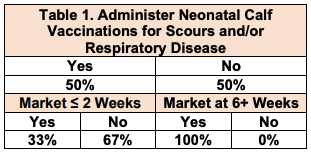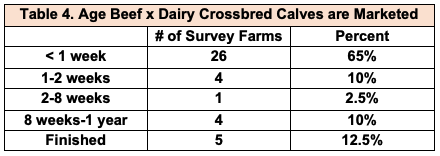Part 2: Calf care and marketing
This project was supported by Agriculture and Food Research Initiative Competitive Grant no. 2021-68008-34110 from the USDA National Institute of Food and Agriculture.
A beef x dairy genetics survey was conducted in 2018, which led to additional research in 2021 when Extension Educators and specialists surveyed 40 Wisconsin dairy farms utilizing beef x dairy genetics. In addition to sire selection, the 2021 survey included newborn calf care and milk-feeding practices. This article highlights some of the calf management results, with greater detail available in the corresponding white paper. Both the 2018 and 2021 white papers are available for download.
Part 1 of this series highlights the survey results regarding beef semen use and how beef sires are selected
on Wisconsin dairy farms.
Calf care practices
One of the key objectives of the 2021 survey was to dig deeper into calf care practices. Thirty farms marketed
most of their beef x dairy crossbred calves at 2 weeks of age or less, and ten farms marketed the majority at
six weeks or greater. For the beef x dairy crossbred market to remain sustainable, crossbred calves need
healthy immune systems when they leave the farm. Healthy immune systems allow these calves to better cope
with the stress of moving to grower facilities. When asked about their overall care of beef x dairy crossbred
calves, 87% of respondents indicated both dairy replacement and beef x dairy crossbred calves received the
same newborn practices. However, when we asked about specific practices, differences emerged. For
example, vaccine use varied depending on if the farmer retained ownership of the calf. When asked about
scours and/or respiratory vaccine usage on the crossbred calves, 50% said they administered these vaccines
(Table 1).
Farmers retaining ownership provided neonatal vaccinations more often. The decision to vaccinate, or not vaccinate, young calves before leaving the farm may be based on the product used (and its associated
meat withdrawal), where the calves are going, and the calf’s age. Neonatal vaccine use by farmers on calves before they leave the farm is an area for future research.
All farmers reported the amount of colostrum fed at first feeding and how soon after birth beef x dairy calves received their first feeding. Ninety-five percent (95%) reported feeding colostrum within six hours of birth, with the remaining 5% feeding colostrum within 12 hours of birth (Table 2).
Sixty-eight percent (68%) reported feeding at least 4 quarts of colostrum (Table 3), with the remaining 32%
feeding lesser amounts (13 farmers).

Based on these results, it appears that farmers are feeding colostrum in a timely manner. It is less clear if
sufficient amounts of colostrum were being fed. Nine of the 13 farmers providing less than 4 quarts of
colostrum at first feeding reported providing a second feeding of colostrum. Four of the 13 farmers providing
less than 4 quarts of colostrum at first feeding did not provide a second feeding. Without testing calves IgG
levels and collecting further information, it is unknown if the farms feeding less than 4 quarts at first feeding are
achieving adequate passive transfer of immunity.
Marketing
Wisconsin dairy bull calves have traditionally been sold at a young age. To determine if beef x dairy crossbred
calves are also sold at a young age, we asked farmers to indicate the calf’s age when the majority of their beef
x dairy crossbred calves are marketed.
Our survey results indicated 65% of farms market beef x dairy crossbred calves at less than one week of age
(Table 4). Some farmers retain ownership of their beef x dairy crossbred calves through weaning or to finish. This presents new opportunities and challenges to determine how a beef x dairy enterprise can efficiently utilize the dairy farm’s resources. Dairy managers will also need to learn how to adopt sound practices for managing crossbred cattle on feed.
Marketing of beef x dairy crossbred calves was evenly split between using auction barns (60%) and private
sales (57%) (Table 5). Several farmers indicated they used more than one marketing method. Farmers also
indicated they used contract programs. One farmer harvests their finished cattle for direct sale to consumers.
The number of farmers using auctions, direct sales, and contract programs shows potential for enhancing communication between beef x dairy calf producers and buyers. Sharing the calf’s genetics and health records with the buyer will increase trust between the dairy and beef sectors.




 Crossbreeding Can Benefit Cow-calf Producers
Crossbreeding Can Benefit Cow-calf Producers Determinación del estado de preñez bovino
Determinación del estado de preñez bovino Direct Marketing Beef: Adding Value to your Product
Direct Marketing Beef: Adding Value to your Product  Establishing alfalfa following wheat
Establishing alfalfa following wheat


